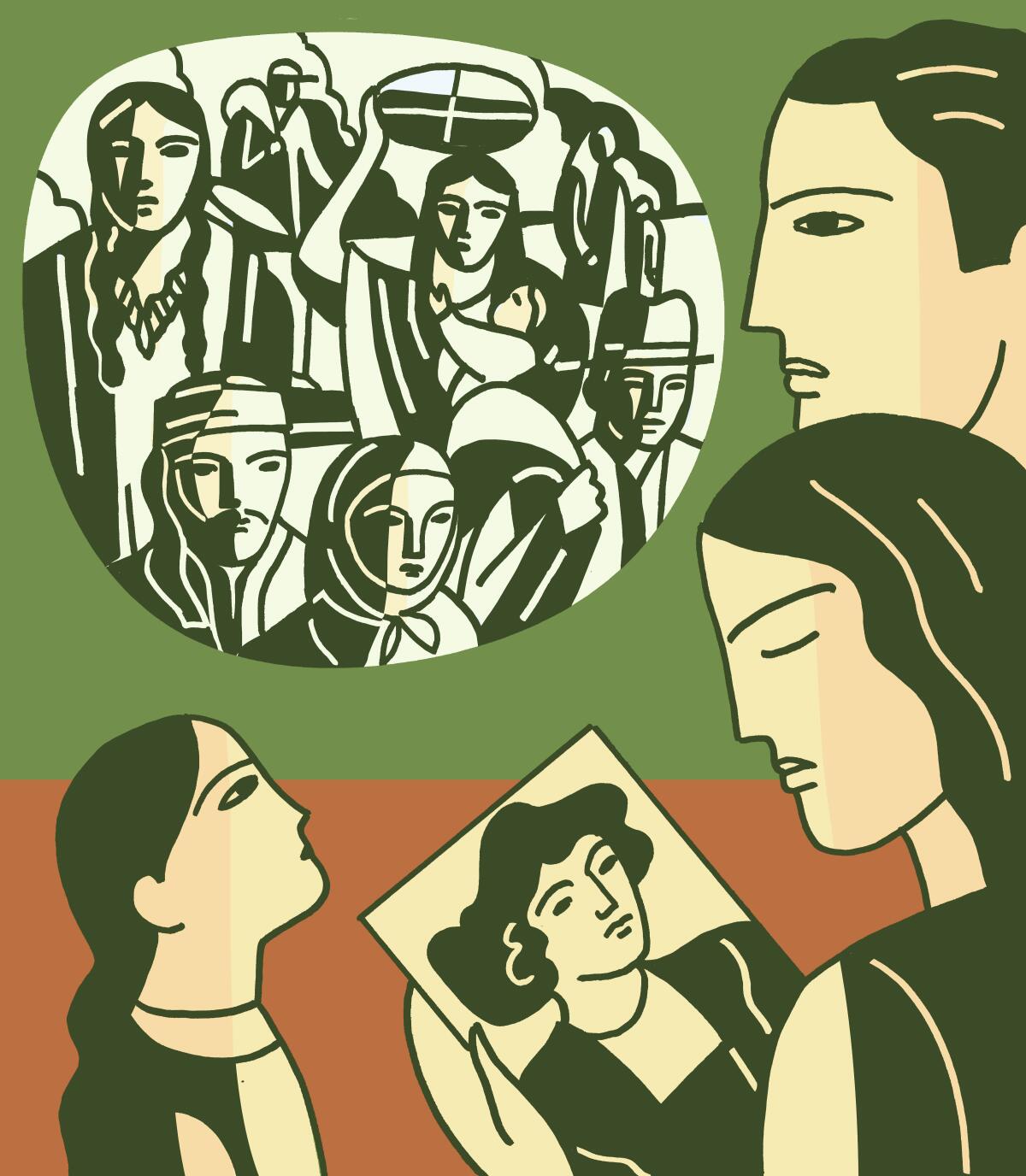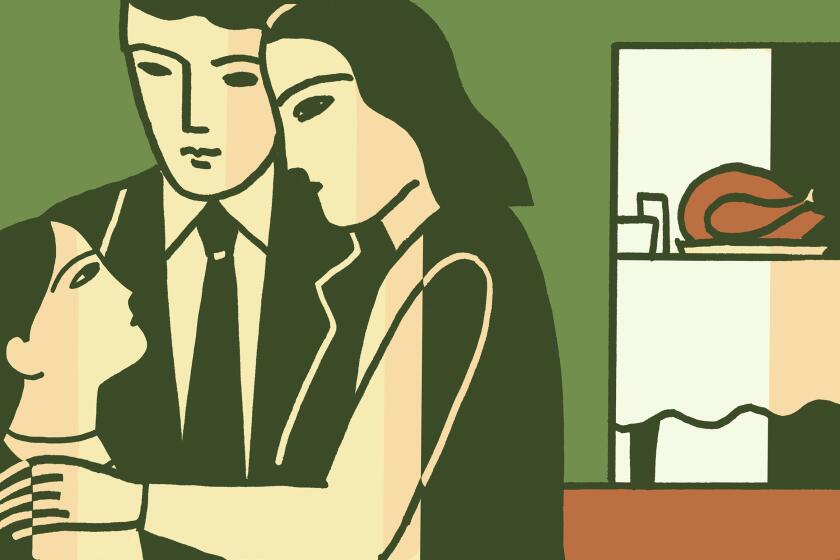Column One: A family learns to tell a new kind of Thanksgiving story

- Share via
It’s hard to say when or how it started, but a few years ago my husband and I quit celebrating Thanksgiving.
The decision came gradually, after many conversations, after many autumns wrestling with the same uneasy feeling that came each time we gathered around a table to give thanks, to stuff our bellies full.
As immigrants from El Salvador and Armenia, we know about the sorrow of having our pasts rewritten, our genocide and massacres, time and time again, neglected or denied.
At first, forgoing the feast came easy. I volunteered to work. We lounged around the house.
Then we had our first child.
With her presence came this pressure, a responsibility to teach her all the truths about the founding of this country that as kids we were never taught.
But where do you begin to educate your child when some of your most vivid memories from grade school are of wearing handmade buckle-top Pilgrim hats and feathered Indian headbands? Growing up, I performed in at least two Thanksgiving feast plays, bringing to life one of two characters: Happy Pilgrim. Happy Indian.
I wanted to call my friend Jason, a full-blooded Navajo and the only Native person I’ve ever known. But it felt odd to ask him, out of the blue: Hey, Jason, how do I explain to my daughter what really happened to your people?
Our girl was tiny then, just starting to talk. Every Thanksgiving we took her out to nature. We’d walk, collect sticks, help her dig her chubby, dimpled fingers in the soil. This became our way of pausing, of thanking the original inhabitants of this land.
Of course, time flies, and before I knew it, our daughter was a big sister. She was in kindergarten and her mind was soaking up all sorts of facts; each day she challenged us with questions: Mama, did you know the blue whale is the biggest animal that ever existed? Mama, why does everything say “Made in China”? Mama, how come people choose to break each other’s hearts?
One fall day, I was emptying her backpack and found a small, stapled booklet with a familiar face on the cover: Christopher Columbus. My stomach sank as I flipped through the pages and saw how dutifully my girl had tried to stay inside the lines as she colored each chapter of his transatlantic voyage to discover the Americas.
“I know this might be confusing,” I told her. “But I need you to know this man is not a hero. He and many others caused a lot of people a lot of pain. When you’re older, Papa and I will tell you more of the story.”

But the truth was, we still had no clue how to start. And if we couldn’t begin telling our children this nation’s story, how could we ever speak to them about our personal histories?
One day, my husband would need to guide our kids through the Armenian genocide, tell them how the Ottoman Empire, now modern-day Turkey, systematically killed 1.5 million Armenians between 1915 and 1923.
One day, I’d need to tell them that, back in the 1980s, my family and I fled El Salvador because a powerful oligarchy, with help from the United States, waged a war that killed more than 75,000 Salvadorans. A Truth Commission for El Salvador report attributed 85% of the acts of violence to state agents.
How do you look at your child and say: Here, my love, take this painful burden.
Then again, how do you stay silent and leave the storytelling entirely to others — to school systems and schoolbooks that have for generations left so much of us out?
In grade school, my mother had no way to question anything I was taught. She was an immigrant, a teenager from a small Salvadoran village whose education came to a halt in fifth grade. Each time I came home with a permission slip for her to sign, I witnessed her struggle at our dining table: the way she sat down, gripped the pen real tight and, then, with the slow, hesitant fear of a child, shakily looped her way around each of the 13 cursive letters making up her first and last name.
One thing about living in the United States that we caught on to real fast were the holidays. For each ritual on the calendar, we learned what props to buy and just how to perform — greeting cards on Valentine’s Day, green clothing on St. Patrick’s Day, costumes on Halloween.
The only script we never fully learned to follow was Thanksgiving.
The gratitude part was easy. My die-hard Catholic mother will seize any chance to round us up and give God props. But the food? That was a different story.
Sitting at home each year with our paper plates and our panes con chumpe (a traditional Salvadoran turkey sandwich), I pictured the rest of America at a bountiful table lined with fine china, re-creating Norman Rockwell’s “Freedom From Want,” that famous painting with the matriarch presenting her family a perfect Thanksgiving turkey on a platter.
Until this day, I’ve only seen stuffing, carved ham and cranberry sauce in TV commercials, grocery store fliers or out in the wild at newsroom potlucks.
I admitted some part of this to a white co-worker years ago. Her jaw dropped, right before she asked, half-joking: “What kind of American are you?”
I’ve learned over the years that as a Salvadoran immigrant raised in this country, I’m the kind of American whose history can easily be erased.
Up until a year ago, I knew nothing of my own roots, my mestizo-indigenous past.
From reading, I recently found that much of my Salvadoran Spanish, the beautiful caliche words I rarely use outside my home because, who will understand — encachimbada (angry), guishte (shard of glass), fufurufa (snobby), chambón (messy) — are part of a dialect influenced by the Pipil people of western El Salvador.
I also learned that one of the main reasons why millions of Salvadorans live in brutal poverty until this day is because after El Salvador gained independence in the 1820s, the government, in a series of decrees, seized the communal lands of the indígenas and then forced them to work the land for dirt-cheap wages.
Any time these campesinos protested, they were met with deadly military force. That was the case in 1932, when one general led La Matanza, the killing of more than 30,000 people, wiping out through genocide much of El Salvador’s indigenous language and customs. (These cultures in recent years have begun to resurge.)
Este año nuestra familia aprendió a contar un tipo diferente de historia de Acción de Gracias.
As a journalist, I’ve found myself wanting to share these and other truths about Central America, including the painful ways the U.S. has destabilized for decades nearly every aspect of life in this region.
To do this, I recently attended a writing workshop, a seminar that motivates journalists of color to publish their personal stories. For two days, I listened to powerful essays written by a group of black, Latino, Asian and South Asian peers. Among us, there was one Native American — a member of the Acoma Pueblo nation.
Rhonda LeValdo, a journalist and professor from Kansas, read out loud a piece she wrote about the trauma and exhaustion of having to continually deal with people who gloss over the history of her Native American ancestors — those millions of people who were once killed, robbed of their land, tradition and language.
The months of October and November are difficult for her to bear: There’s the parade of Indian Halloween costumes — Pocahontas, Indian with war paint, dead Indian with an arrow in his eye.
With Thanksgiving come construction-paper headdresses, Pilgrim costumes and the reenactment of that perfect Plymouth meal.
“Do non-Natives believe that because our numbers are so low in population that we don’t matter?” LeValdo wrote. “Some non-Natives want to remember us fondly as still wearing buckskin, headdresses and portraying the noble savage.”
A day after I came home from the workshop, I was emptying my daughter’s backpack when I found an invitation. It was to a play she would be starring in: “Thanksgiving at Plymouth!”
The script focused on Squanto, a Pawtuxet man who was enslaved by English traders and later heartbroken to find that his people were “wiped out by diseases from England.”
Squanto went on to support the cold, hungry Pilgrims who fled to America seeking religious freedom. He helped them from sunrise to sundown, became their teacher and friend.
In the end, the Pilgrims invited the Native Americans to a feast. The Pilgrims “gave thanks for all that they had. Pilgrims and Native Americans together were glad.”
I stared at that happy ending for a while, read it several times.
I thought of my daughter’s first-grade teacher, of all the teachers who over time will come into her life and, bit by bit, shape her mind with their hard work, their best intentions.
Folded within the doughy wrapper is a family’s story of humble roots, columnist Frank Shyong writes. The holidays offer a chance to reexamine our narratives of our families.
I walked over to my daughter, sitting at the dining table.
“How do you feel about this play?” I asked her.
“A little weird,” she said, without looking up from her homework. “I’m not sure if it’s all true, but if it isn’t, then what is true?”
“I wish I could answer you right now,” I told her. “We’re going to do some research and figure it out together.”
In coming days, books began to arrive by mail at our front door, children’s titles I carefully selected after scouring the internet.
Many came recommended by a Native educator who runs a site that critiques children’s books written about Native people.
Together, the characters in these books taught our family more about humanity than we’d ever learn from that old familiar play.
From a Cree grandmother, we found that though her government boarding school once forced her to blend in with the others “like a flock of crows,” she persisted, wearing her long hair and bright colors.
From a Lipan Apache boy, a demonstrator at Standing Rock, we learned that one small protest, with help from others, could turn into a worldwide movement.
And from a book about Cherokee traditions, we uncovered a new word: otsaliheliga.
That’s what people say to express gratitude — to remember their blessings and their struggles — across all seasons.
More to Read
Sign up for Essential California
The most important California stories and recommendations in your inbox every morning.
You may occasionally receive promotional content from the Los Angeles Times.










